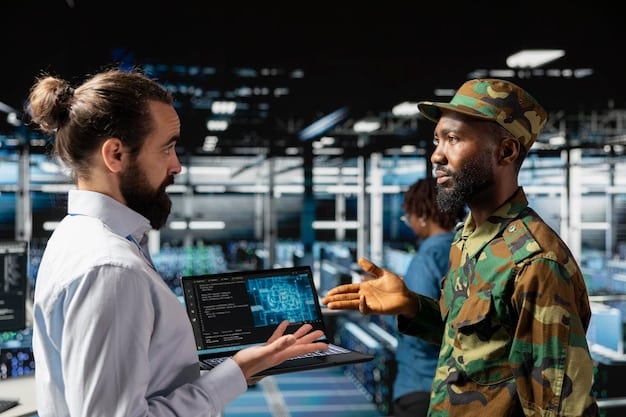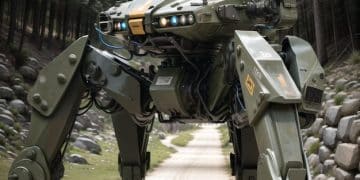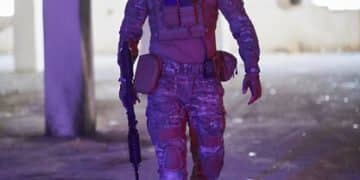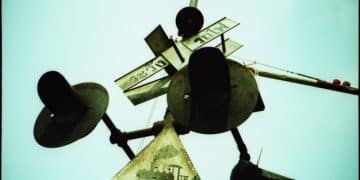Army’s Robotic Combat Vehicle: Impact on Infantry Tactics by 2025

The U.S. Army’s new Robotic Combat Vehicle (RCV) will fundamentally reshape infantry tactics by 2025, deploying autonomous and semi-autonomous systems to enhance soldier protection, extend situational awareness, and increase lethality at the vanguard of combat operations.
The dawn of robotic warfare is no longer a distant theoretical concept but a tangible reality rapidly approaching the battlefield. As militaries worldwide invest heavily in advanced autonomous systems, a critical question arises: How Will the Army’s New Robotic Combat Vehicle Impact Infantry Tactics by 2025? This question delves into a complex interplay of human-machine teaming, ethical considerations, and a fundamental shift in how ground forces operate, promising a future where combat units are leaner, smarter, and significantly more resilient.
The Genesis of the Robotic Combat Vehicle Program
The U.S. Army’s Robotic Combat Vehicle (RCV) program is a testament to its commitment to modernizing its forces and maintaining a technological edge. The concept of integrating uncrewed ground vehicles (UGVs) into combat operations has evolved from science fiction to a strategic imperative. The primary driver behind the RCV program is the recognition that future battlefields will be characterized by increased lethality, contested physical and electromagnetic environments, and the need for greater stand-off capabilities to protect human soldiers. Early prototypes and developmental efforts have focused on understanding the optimal balance between autonomy, remote control, and human oversight. The Army envisions several variants of RCVs, ranging from light scouting platforms to heavy combat support roles, each designed to perform specific tasks that either augment or replace manned systems in high-risk zones.
The RCV program isn’t just about building robots; it’s about developing an entirely new ecosystem of hardware, software, and operational doctrines. This includes robust communication networks, advanced artificial intelligence for decision-making, and user-friendly interfaces that allow human operators to effectively command and control multiple robotic systems simultaneously. The timeline to 2025 is ambitious, highlighting the urgency with which the Army views this transformation. Initial deployments are expected to focus on relatively simpler tasks, gradually integrating more complex capabilities as the technology matures and soldier trust in these systems grows. The lessons learned from early trials will be crucial in refining the RCVs’ design and operational parameters, ensuring they meet the demanding requirements of modern warfare.
Early Prototypes and Lessons Learned
Initial RCV prototypes, such as the RCV-Light, Medium, and Heavy concepts, have undergone rigorous testing in various environments. These tests have provided invaluable data on performance, reliability, and the practical challenges of integrating such systems into existing formations.
- Enhanced Situational Awareness: RCVs equipped with advanced sensors can scout dangerous areas, providing real-time intelligence without risking human life.
- Increased Lethality: Weaponized RCVs can engage targets, supporting infantry pushes or holding key positions from a distance.
- Logistical Support: Some RCV variants are designed to carry supplies, reducing the burden on soldiers and freeing them for combat roles.
These early iterations are paving the way for more sophisticated designs, emphasizing modularity and adaptability to various mission sets. The feedback from soldiers operating these prototypes is continuously integrated into the development cycle, ensuring that the final products are not only technologically advanced but also practical and effective in the field. The Army is committed to ensuring that RCVs are not just supplementary but integral components of future infantry operations.
The RCV’s Role in Reconnaissance and Security Operations
The integration of Robotic Combat Vehicles into reconnaissance and security operations represents one of the most immediate and impactful shifts for infantry tactics by 2025. Traditionally, recon missions involve small teams of soldiers moving covertly into enemy territory, a task inherently fraught with danger. RCVs, especially the lighter variants, are poised to revolutionize this by acting as the vanguard, pushing ahead of manned elements to detect threats, survey terrain, and establish early warning perimeters. Their ability to operate in contested or chemically hazardous environments without risking human life makes them invaluable assets for intelligence gathering. Equipped with advanced optical, thermal, and acoustic sensors, RCVs can provide a comprehensive picture of the battlefield, transmitting data back to human operators in real time. This capability extends the infantry’s reach and perception, allowing for more informed decision-making and safer operational execution.
Furthermore, RCVs in security roles can patrol vast areas, monitor critical infrastructure, or guard flanks during offensive operations. Their persistent presence and array of sensors can deter potential adversaries or provide immediate alerts of incursions. This frees up human soldiers from mundane and dangerous patrol duties, allowing them to focus on more complex tactical tasks or rest. The RCV’s robust construction and potential for armed deterrence add another layer of security, creating a more formidable defensive posture. The synergy between human reconnaissance teams and RCVs will be key, with soldiers directing robotic assets to investigate suspicious areas or to maintain watch while they reposition. This human-machine partnership is designed to amplify the effectiveness of infantry, making them more agile and resilient in securing objectives.
Extending the Infantry’s Sensory Reach
RCVs are designed to push the boundaries of perception, offering infantry units a significant advantage in understanding their operational environment. Their sophisticated sensor packages mean that threats can be identified earlier and from a greater distance.
- Thermal and Night Vision: Superior imaging capabilities for all-weather, 24/7 operations.
- Acoustic and Chemical Sensors: Detection of hidden enemies or environmental hazards.
- LIDAR and Radar: Precision mapping and obstacle avoidance in complex terrains.
These extended sensory capabilities translate directly into enhanced soldier protection. By identifying threats from a safe distance, infantry units can either choose to engage with overwhelming force or bypass them entirely, reducing the likelihood of unexpected engagements and casualties. The data collected by RCVs will also feed into broader intelligence networks, contributing to a more robust and adaptive common operating picture for commanders at all levels. This proactive approach to reconnaissance and security is a game-changer for infantry tactics.

Amplify Firepower and Soldier Protection
The introduction of Robotic Combat Vehicles offers a substantial leap forward in both amplifying firepower and enhancing soldier protection for infantry units. By equipping RCVs with various weapon systems, from machine guns to anti-tank missiles, the Army can deploy significant combat power without directly exposing human soldiers to enemy fire. These robotic platforms can lead an assault, providing suppressive fire, or hold positions against overwhelming odds, absorbing damage that would otherwise be inflicted upon manned vehicles or ground troops. This “force multiplication” effect allows infantry commanders to achieve tactical objectives with fewer human soldiers in harm’s way, fundamentally altering the risk calculus of combat operations. The ability of RCVs to operate in concert with infantry, providing covering fire or engaging targets spotted by human scouts, creates a dynamic and lethal combat team.
Moreover, RCVs can serve as decoys or sacrificial assets, drawing enemy fire and revealing their positions before infantry units are committed. Their robust construction and remote operation mean that even if an RCV is damaged or destroyed, the primary cost is material, not human life. This psychological advantage for friendly forces, knowing that a robot can take the first blow, can boost morale and reduce combat stress. The RCV’s integration also allows for a more distributed and less predictable battle array, as units can leverage robotic platforms to extend their perimeter or respond to threats from multiple directions simultaneously. This layered defense and offense capability makes infantry units far more resilient and adaptable to a rapidly evolving battlefield.
Tactical Integration and Joint Operations
Effective integration of RCVs necessitates new tactical doctrines and training regimes for infantry. Soldiers will need to learn how to seamlessly command, coordinate, and trust their robotic counterparts in complex combat scenarios.
- Combined Arms Maneuver: RCVs will integrate with tanks, armored personnel carriers, and air support to achieve synergistic effects.
- Urban Warfare: Robotic platforms can clear buildings, scout alleyways, and conduct reconnaissance in densely populated areas, reducing risks to human entry teams.
- Breaching Operations: Specialized RCVs can undertake dangerous tasks like mine clearance or obstacle removal, paving the way for advancing infantry.
The concept of “human-on-the-loop” or “human-in-the-loop” control is paramount, ensuring that humans retain ultimate decision-making authority over lethal actions. This ethical consideration guides the development and deployment of RCVs, ensuring that these advanced machines serve as tools to support and protect soldiers, not to replace their judgment. The goal is to create a more effective fighting force where human ingenuity and robotic resilience combine to dominate the modern battlefield.
Logistical and Support Implications for Infantry
The deployment of Robotic Combat Vehicles will have profound logistical and support implications for infantry units by 2025, moving beyond mere combat roles to redefine the entire support infrastructure. RCVs can be configured to carry essential supplies, ammunition, water, and even provisions for medical evacuation, significantly reducing the physical burden on individual soldiers. In harsh terrains or during prolonged operations, this capability can be a game-changer, increasing the endurance and operational range of dismounted infantry. By having robotic mules accompany them, soldiers can focus on combat tasks rather than constantly managing heavy loads, leading to less fatigue and higher combat effectiveness. The ability to autonomously resupply forward-deployed units without risking manned convoys in dangerous areas offers a strategic advantage.
Furthermore, RCVs can assist in engineering tasks, such as clearing obstacles, digging defensive positions, or constructing temporary fortifications. Their ability to operate continuously for extended periods, perhaps with quick battery swaps or refueling, means that critical support functions can be maintained around the clock. The maintenance and repair of these robotic systems will also necessitate new skill sets within infantry support echelons, requiring technicians trained in robotics, software diagnostics, and advanced field repairs. This shift implies a recalibration of existing support structures, emphasizing technical proficiency alongside traditional logistical roles. The ultimate vision is a more agile, self-sufficient, and less vulnerable infantry force, supported by a network of interconnected robotic assets that handle the heavy lifting and high-risk support functions.
New Training Paradigms and Personnel Requirements
The integration of RCVs demands a fundamental rethinking of infantry training programs. Soldiers will need to become proficient in operating, maintaining, and fighting alongside these robotic systems.
- Operator Training: Developing expertise in remote control, mission planning, and tactical deployment of RCVs.
- Maintenance Specialists: Training personnel in the unique mechanical and software aspects of robotic combat systems.
- Human-Machine Teaming: Fostering trust and seamless communication between soldiers and AI-driven platforms.
These new training paradigms will ensure that future infantry are not just soldiers, but also technologists, capable of leveraging the full potential of their robotic counterparts. The goal is to move beyond simple operation to truly integrate RCVs as an extension of the combat team, requiring a deep understanding of their capabilities and limitations. This adaptability in training is crucial for maximizing the force multiplier effect that RCVs promise to deliver.
Challenges and Ethical Considerations
While the potential benefits of Robotic Combat Vehicles are immense, their integration into infantry tactics by 2025 is not without significant challenges and complex ethical considerations. One of the primary technical hurdles is ensuring robust and secure communication links, especially in environments where adversaries may employ electronic warfare to jam or even hijack robotic systems. The reliability of AI-driven decision-making in unpredictable combat scenarios also remains a critical area of development. Autonomous systems must be able to distinguish between combatants and non-combatants, adhere to rules of engagement, and operate effectively even when faced with novel situations not anticipated by their programming. The “human-in-the-loop” or “human-on-the-loop” control philosophy aims to maintain human accountability for lethal decisions, but the speed of combat often blurs these lines, raising questions about reaction times and the delegation of authority.
Beyond the technical, the ethical and moral implications of deploying lethal autonomous weapons systems are profound. Public perception, international treaties, and the ‘killer robot’ debate are significant factors that the Army must navigate. Ensuring transparency in their development and deployment, as well as establishing clear accountability frameworks, will be crucial. Furthermore, the psychological impact on soldiers operating alongside machines that can kill is an area that requires careful study. Will it desensitize them to violence, or empower them with a sense of safety? These questions highlight the need for a comprehensive approach that considers not just the technological capabilities of RCVs but also their broader societal and human dimensions. The Army must commit to addressing these challenges head-on to effectively and ethically integrate RCVs into its future force.
Defining Autonomy and Accountability
The debate around “autonomy” in RCVs is centered on how much decision-making power is delegated to the machine versus retained by human operators. This directly impacts accountability in the event of unintended harm or breaches of the law of armed conflict.
- Human-in-the-Loop: A human always makes the final decision to engage.
- Human-on-the-Loop: A human supervises the system, which can execute decisions autonomously but can be overridden.
- Human-out-of-the-Loop: Fully autonomous systems that make and execute lethal decisions without direct human intervention (currently not pursued by the U.S. Army for lethal systems).
Establishing clear lines of accountability for actions taken by robotic systems is paramount. This includes defining who is responsible for software malfunctions, unexpected behaviors, or errors in target identification. The legal and ethical frameworks surrounding autonomous weapons are still evolving, and the Army’s approach to RCV deployment will inevitably influence these critical discussions on a global scale. Navigating these complexities responsibly is as important as mastering the technology itself.

Training and Doctrine Evolution for a Robotic Future
The successful integration of Robotic Combat Vehicles into infantry tactics by 2025 demands a significant evolution in both training methodologies and military doctrine. It’s no longer sufficient for soldiers to be proficient solely in traditional infantry skills; they must also become adept at operating, maintaining, and tactically employing robotic assets. This shift necessitates new curricula at basic training, advanced individual training, and leadership development courses throughout the Army. Soldiers will transition from being merely combatants to “combat systems operators and integrators,” capable of commanding small fleets of robotic units with the same dexterity they handle their personal weapons. This change implies a heavy investment in simulation technology and virtual reality training, allowing soldiers to practice complex human-machine teaming scenarios in a safe, controlled environment before live-fire exercises.
Doctrinally, the Army will need to rewrite its field manuals and standard operating procedures to reflect the capabilities and limitations of RCVs. This includes developing new formations, engagement rules, and command and control structures that seamlessly incorporate robotic platforms. The concept of “distributed lethality” will gain prominence, where infantry units, augmented by RCVs, can engage multiple targets simultaneously and from various angles, creating a highly dynamic and confusing battle space for adversaries. Furthermore, cross-training between different combat arms and support functions will become essential, as RCVs will require integrated logistical, maintenance, and intelligence support. This holistic approach to training and doctrine ensures that the RCVs are not just technological add-ons, but fully integrated and force-multiplying components of the infantry.
Adapting to Human-Machine Teaming Dynamics
The effectiveness of RCVs hinges on the quality of human-machine teaming. Soldiers must develop trust in their robotic partners, understanding their capabilities and anticipating their actions.
- Shared Understanding: Training emphasis on clear communication and common operational pictures between humans and AI.
- Role Specialization: Defining distinct roles for humans (decision-makers, strategists) and robots (sensors, effectors, burden-carriers).
- Ethical Deliberation: Regular discussions on the ethical implications of robotic warfare to foster responsible decision-making.
This adaptation extends beyond individual soldier skills to unit cohesion, where teams learn to operate as a blended force. The ability to switch seamlessly between direct human action and robotic deployment, to leverage the strengths of each, will distinguish effective infantry units in the future. The evolution in training and doctrine is therefore less about technology and more about human adaptation to a technologically advanced combat environment, preparing soldiers for a new era of warfare where machine partners are commonplace.
The Future Infantryman: A Hybrid Combatant
By 2025, the U.S. Army’s new Robotic Combat Vehicle program promises to transform the conventional infantryman into a truly hybrid combatant, proficient in both traditional ground warfare and advanced human-machine teaming. This evolution signifies a radical departure from past norms, where the soldier was solely the primary effector on the battlefield. The future infantryman will be a commander of robotic assets, an information sponge processing real-time data from autonomous scouts, and a tactician leveraging machine resilience to gain a decisive edge. This transformation is not about replacing soldiers with robots, but rather empowering them with an array of tools that extend their reach, enhance their protection, and multiply their effectiveness. The infantry squad will become a nexus of integrated capabilities, where human intuition and robotic precision combine to create a formidable force.
This hybrid combatant will operate within a more distributed and adaptable battle network. Instead of rigid formations, infantry units will be able to dispatch RCVs to dangerous fronts, flank enemies remotely, or provide suppressive fire from multiple, unexpected directions. The emphasis will shift from brute force to intelligent application of resources, where human leaders choreograph a ballet of manned and unmanned systems to achieve tactical superiority. The psychological and physical burdens on soldiers will be significantly reduced, allowing them to focus on mission critical tasks that require uniquely human attributes like creativity, complex problem-solving, and empathy. The future infantryman, augmented by an RCV, will be more lethal, more survivable, and more adaptable, ready to face the complexities of future conflict with a new era of technological prowess.
Societal and Strategic Implications
The integration of RCVs will have broader societal implications, impacting recruitment strategies, public perception of warfare, and the geopolitical landscape. The Army must address questions surrounding the human cost of a less human-centric battlefield.
- Recruitment: Attracting tech-savvy recruits who are comfortable with advanced robotic systems.
- Public Discourse: Managing public perception and ethical debates surrounding autonomous weapons.
- Strategic Stability: The impact of robotic armies on deterrence and the balance of power among nations.
The strategic implications are equally significant. Nations that effectively integrate RCVs will likely gain a substantial military advantage, potentially altering global power dynamics. This drives a powerful imperative for the U.S. Army to lead in this technological domain, ensuring that its infantry remains at the forefront of combat innovation. The robotic future of infantry is not just a technological upgrade; it is a fundamental redefinition of the soldier and the nature of ground combat.
| Key Aspect | Impact on Infantry Tactics by 2025 |
|---|---|
| 🛡️ Soldier Protection | RCVs act as a forward shield, absorbing enemy fire and reducing direct human exposure in hazardous zones. |
| 🧠 Situational Awareness | Advanced sensors on RCVs extend an infantry unit’s perception, providing real-time intelligence from deeper and more dangerous areas. |
| 💥 Lethality Enhancement | Weaponized RCVs add significant firepower, enabling infantry to engage targets from a safer distance and multiply their combat effect. |
| 🤝 Human-Machine Teaming | Infantry will train to seamlessly integrate RCVs, leading to new doctrines emphasizing collaborative and distributed operations. |
Frequently Asked Questions About RCVs and Infantry Tactics
An RCV is an uncrewed ground vehicle developed for combat roles, designed to operate semi-autonomously or remotely controlled by human soldiers. These vehicles are intended to augment infantry units, providing reconnaissance, security, enhanced firepower, and logistical support without risking human life in the most dangerous situations.
RCVs will lead operations into hazardous areas, acting as a forward screen to detect threats and absorb enemy fire. By scouting ahead or holding critical positions, they reduce soldiers’ direct exposure to danger, thereby significantly enhancing their safety and survivability during combat engagements.
No, the current doctrine emphasizes that RCVs are designed to augment and support human soldiers, not replace them. Human operators will remain “in the loop” or “on the loop,” retaining ultimate decision-making authority, especially regarding the use of lethal force. They are tools to enhance soldier effectiveness.
Infantry soldiers will require new skills in remote operation, mission planning for unmanned systems, data interpretation from RCV sensors, and human-machine teaming. Training will also focus on basic field maintenance and troubleshooting of robotic systems, transforming soldiers into hybrid combatants and system integrators.
Key ethical considerations include ensuring compliance with the laws of armed conflict, the ability to distinguish combatants from non-combatants, accountability for actions taken by autonomous systems, and the potential for a reduced human threshold for initiating conflict. The Army is actively working to establish clear ethical guidelines.
Conclusion
The integration of the U.S. Army’s new Robotic Combat Vehicle (RCV) will undeniably revolutionize infantry tactics by 2025. This pivotal shift will see soldiers transition into hybrid combatants, adept at commanding robotic systems that significantly enhance reconnaissance, amplify firepower, and critically, bolster soldier protection. The RCV is not merely an addition to the arsenal; it represents a fundamental redefinition of combat operations, demanding new training paradigms, evolving doctrines, and careful navigation of ethical complexities. As these intelligent machines become increasingly interwoven with human elements, the future infantry promises to be a more resilient, adaptable, and technologically superior force.





